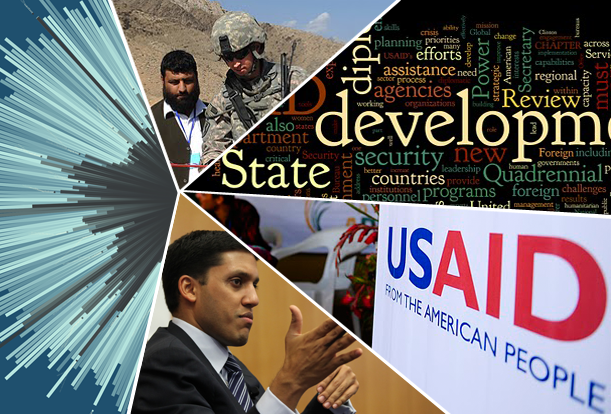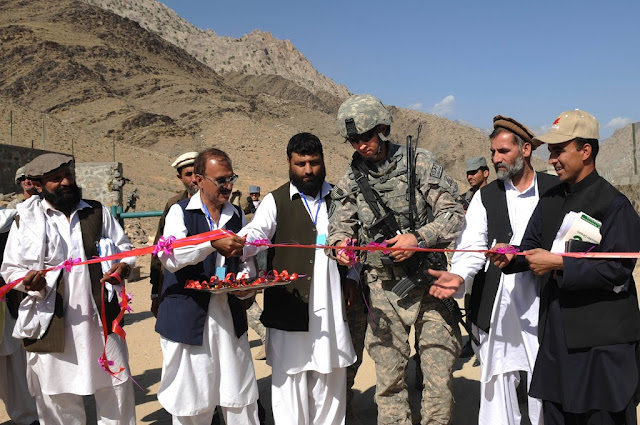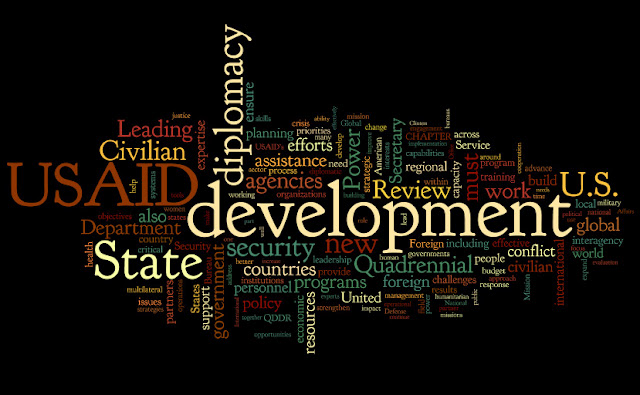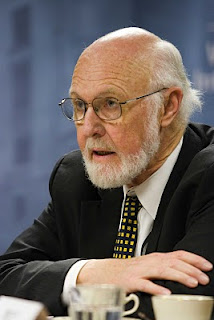-
QDDR Coverage Wrap-up: Institutional Shifts, Development-as-Security, Women’s Empowerment, and Complex New Threats
›February 23, 2011 // By Schuyler NullSomewhat lost in the wake of turmoil in the Middle East and the budget battle in Congress has been the State Department’s most aggressive attempt yet to reshape itself for the dynamic foreign policy challenges of the 21st century.
-
Civilian Power in a Complex, Uncertain World
›Leading Through Civilian Power: The First Quadrennial Diplomacy and Development Review (QDDR) initiates an encouraging process of rethinking and restructuring that is long overdue. It explicitly links itself to the 2010 National Security Strategy and echoes the latter’s commitment to “national renewal and global leadership.” It refers briefly to the obvious companion document, the Quadrennial Defense Review, although it resists engaging with some key aspects.
-
First Steps on Human Security and Emerging Risks
›The 2010 Quadrennial Development and Diplomacy Review (QDDR), the first of its kind, was recently released by the State Department and USAID in an attempt to redefine the scope and mission of U.S. foreign policy in the 21st century. Breaking away from the Cold War structures of hard international security and an exclusive focus on state-level diplomacy, the QDDR recognizes that U.S. interests are best served by a more comprehensive approach to international relations. The men and women who already work with the U.S. government possess valuable expertise that should be leveraged to tackle emerging threats and opportunities.
-
Civil-Military Interface Still Lacks Operational Clarity
›The Quadrennial Diplomacy and Development Review (QDDR) is an important first step in redefining civilian roles and capacities in crises, conflict, and instability. After the expensive failures of both the military and USAID in Vietnam during the 1960s and 70s, Congress set new guidelines governing military interventions and assistance to foreign governments. Foreign assistance staff was cut from 15,000 to 2,000 people. When modern-day conflicts arose and USAID found itself understaffed and under-funded, the military was called upon to fill a gap and became overnight, in essence, our primary development agency.
-
Women and Youth in 21st Century Statecraft
›January 10, 2011 // By Richard CincottaWhether one supports or finds fault with current (and envisioned) U.S. diplomacy and international development processes and practices, most foreign policy analysts and academics will recognize the first Quadrennial Diplomatic and Development Review (QDDR) as a landmark document. In my opinion, the QDDR – titled Leading Through Civilian Power – is essential reading for those who seek a career in government or who otherwise need to understand the nature and purpose of the work that foreign service officers and USAID missions perform overseas.
-
USDA v. Taliban
›May 28, 2010 // By Dan AsinAgricultural development is the “top non-security priority” in Afghanistan, said U.S. Secretary of Agriculture Tom Vilsack, in a recent speech. “Unemployment is the best recruiting tool for the Taliban,” he told the Des Moines Register.
Sixty USDA experts are working with their partners in State, USAID, DOD, and other members of U.S. government to increase agricultural opportunities in rural areas of the country. Embedded in small civil-military units of 15-100 people, USDA experts have worked on projects of all scales: installing windmill water pumps, training veterinarians, refurbishing university research laboratories, stabilizing river banks and irrigation canals, and developing storage facilities.
In his keynote speech at the Feed the Future launch, Vilsack emphasized the need to build markets. In Afghanistan, USDA is focusing on improving infrastructure so farmers can receive deliveries and ship produce, and boosting credit vehicles to help farmers purchase the inputs to grow crops. Opium traders provide seeds to the farmers and pick up the crops at the farms, he said, which makes opium easier to produce than legal crops.
Alternative crops could be just as or more valuable, Vilsack told NPR:Table grapes are in some cases perhaps four and five times more valuable than poppy. Saffron, almonds, pomegranates, a number of fruits are significantly more profitable. What we have to do is we have to establish that the reward of putting those crops in the ground is greater and the risk is equal to or less than poppy production.
On the same NPR program, Vilsack’s counterpart agreed: “Agriculture growth means employment and employment means security. They’re so much related to each other. In places where the military operates, if you do not offer people the future, just by military means, security and stability will be a very far-reaching dream,” said Minister of Agriculture, Irrigation, and Livestock Mohammad Asif Rahimi.
But the Afghan government faces an immense challenge: Afghanistan’s unemployment rate is estimated at 35 percent, which ranks it in the bottom 20 countries in the world. With a population growth rate of 3.5 percent and nearly half the population already under the age of 15, the need for job creation is only set to increase.
While agricultural development and food security are essential, Rahimi acknowledged, alone they are not enough. The Afghan government needs a “whole of government approach,” he said. To win the hearts of its people the government must offer “an alternative to what the Talibans were offering to people…more livelihood and security and education and health, and also a better and more secure future.”
Both Vilsack and Rahimi avoid the common trap of equating hunger with conflict, instead emphasizing agricultural employment and economic opportunities as key to solving that intractable conflict.
But it’s not the only piece of the puzzle. I hope the Feed the Future’s “whole of government” approach in Afghanistan will emphasize not only agriculture, but also the environmental policies and health services, such as family planning, that can ensure that agricultural gains are sustainable even after the troops leave.
Sources: Central Intelligence Agency, Des Moines Register, NPR, United Nations Statistics Division, United Nations Population Division, U.S. Agency for International Development, U.S. Department of Agriculture, U.S. Department of State.
Photo Credit: Colonel Stephen Redman and John Van Horn of the USDA discuss crop plans with local residents while surveying the site of the Arkansas Agribusiness Development Team’s (ADT)demonstration farm plot near Shahr-e-Safa, Afghanistan, courtesy Flickr user isafmedia. -
Reforming Development: New Year’s Resolutions for Policymakers
›The foreign policy headlines are dominated by terrorism, Iraq and Afghanistan, the Arab-Israeli dispute, and North Korea and Iran’s nuclear weapons.
Under the radar, however, a quiet revolution is going on. Policymakers from the Pentagon to Capitol Hill are proposing ways to modernize development policy to meet the demands of foreign policy in the 21st century.
Development Seeking Its Place Among the Three “D”s—Diplomacy, Development and Defense
Three major efforts launched in 2009 are expected to be completed in 2010:- The State Department’s “Quadrennial Diplomacy and Development Review” of operations at State and USAID is due in Fall 2010; preliminary recommendations are scheduled for this month.
- The White House’s review of global development policy will involve all government agencies with development programs. Headed by National Security Advisor Jim Jones and NEC head Larry Summers, the team will report out in the next few months.
- Congress, which for a long time has paid little attention to these issues, also is making development reform a priority. Both the Senate and the House are writing new legislation to replace the current bill, which was last overhauled in 1961.
A new policy framework is long overdue. Everyone agrees that the Obama administration inherited a system that is broken and must be fixed. But how? I propose seven New Year’s resolutions for policymakers trying to revamp development.
1. Address all the myriad issues that impact American interests and for which development aid could be an important policy tool.
Promoting development is critical to a diverse range of cross-cutting issues:- preventing violent conflicts
- restoring economic growth and dampening financial instability
- expanding global trade
- dealing with global climate change
- dealing with global pandemics and other health challenges
- eliminating absolute poverty
2. Lay out a government-wide “national development strategy” that sets clear goals and objectives for US development policy—and doesn’t just tinker with organizations and budgets.
Development promotion, broadly defined, must be an important part of the solution. But any new strategy must go beyond just reforming the aid program.
While needed, new policies and programs are costly. The sooner they are put into place, however, the lower the long-term costs of not addressing them will be.
3. Include all the parts of the U.S. government that are now engaged in promoting development.
Existing development capacities are spread throughout the executive branch, and, in some cases, the private sector. Currently 25 departments, 25 agencies, and almost 60 offices are involved in making or implementing development policy. There is no central oversight, planning, budgeting, implementation, or evaluation.
There must be a central point within the government that monitors and coordinates all development programs. Past experience indicates that only the White House, with a strong presidential mandate, can effectively pull off this coordination. Many previous attempts at reform have foundered because the executive branch refused to take congressional initiative seriously.
4. Reflect on lessons learned over the past 60 years.- While liberalized trade and economic openness can improve growth, each country must craft its own strategies.
- Growth is important, but it alone will not eliminate poverty. Measures that directly address poverty are important for their own sake, and if done right, will enhance economic growth as well.
- Similarly, good governance and democracy are important for growth, but are also important goals in their own right. Participatory decision-making is critical to program success.
- Conflict, with its high human costs, is not caused by poverty and lack of development, but makes the solution to other problems much more difficult.
- Investments in poor people, and particularly poor women, pay high dividends. Measures increasing access to education and health, redistributing productive assets (credit and land), and supporting small-scale rural and urban enterprises are particularly effective.
The United States is now one of many players in the development game. In fact, in all but a few countries, it is not even the major aid provider. In Southeast Asia, China, Japan, or India are more likely to be the major donors; in Africa, it is the European Union or China.
Furthermore, many nongovernmental funders have joined the field. The Gates Foundation has spent more than $12 billion on its Global Health Program. Ford and other U.S. foundations are seeking to rebuild African universities, and companies like Mars and FedEx are running technical assistance programs. In addition, American private voluntary agencies have raised over $10 billion in private funds—more than some European aid donors.
Trade and private financial transactions dwarf official development assistance (ODA). For instance, remittances from migrants to their home countries are approaching US$300 billion a year, nearly 50 percent more than all ODA. Frankly, trade liberalization and financial stability will have greater impact on development than any increase in ODA.
As a result of these seismic shifts, U.S. development policy needs to be smarter and more strategic, mobilizing new and different ways to engage governments, corporations, universities, foundations, and civil society (as is now being done for with HIV/AIDS).
6. Make fundamental changes to existing aid structures, which have atrophied over the years.
Currently, USAID is not equipped to deal with the challenges of the 21st century. It is considerably understaffed and lacks the necessary technical skills, particularly in agriculture and institution-building. The agency has no capacity to think strategically about the global development environment and lacks a voice at policy tables. Furthermore, new independent development agencies, such as the Millennium Challenge Corporation and PEPFAR, have proliferated
A revamped U.S. aid program needs a strategy that would:- Give responsibility for formulating and implementing development strategies to the user country, thereby transferring ownership and increasing effectiveness. Providers, of course, can then choose whether or not they want to support the country’s strategy.
- Agree on a more rigorous, transparent, performance-based approach to allocating ODA.
- Give equal priority to global problems, regional needs, and country priorities.
A long-term commitment is essential because these significant changes will not be implemented overnight. It will take the next three years of President Obama’s tenure (and perhaps longer) to change long-embedded policies and practices. Remember, the Defense Department was established in 1948, but did not fully integrate the three services until the Goldwater-Nichols Act of 1986—almost 40 years later.
New Year’s resolutions are often broken as the tough work of fulfilling them becomes all too apparent. But breaking these resolutions will adversely affect U.S national interests in the coming decades. As Secretary of State Clinton argued recently, development “is a strategic, economic, and moral imperative – as central to advancing American interests and solving global problems as diplomacy and defense.”
The administration and Congress now have an opportunity to set development policy on a new course. Let’s hope they take it.
John Sewell is a senior scholar at the Woodrow Wilson International Center for Scholars.
Showing posts from category State.











